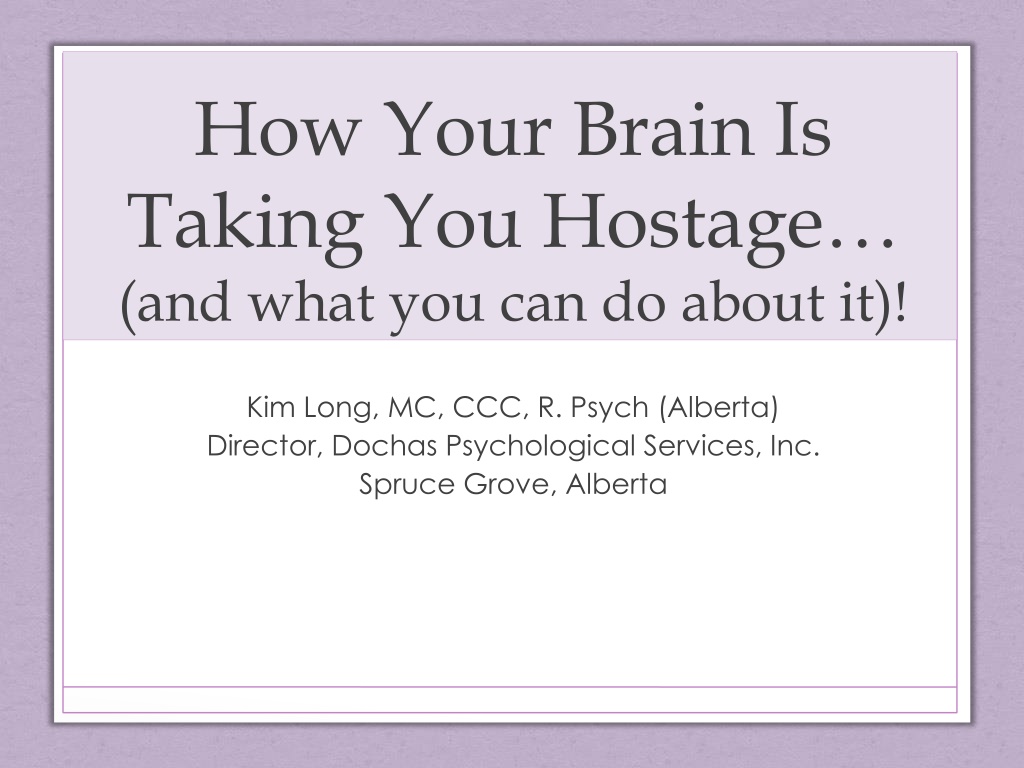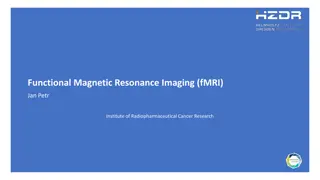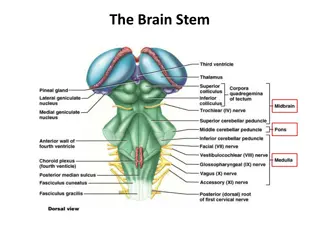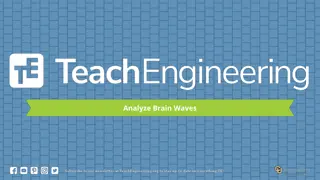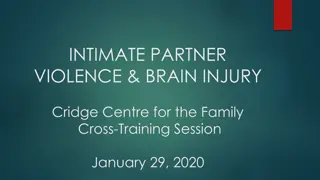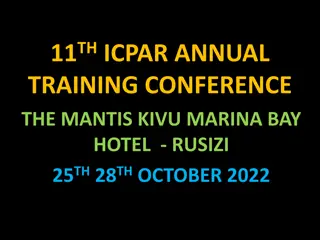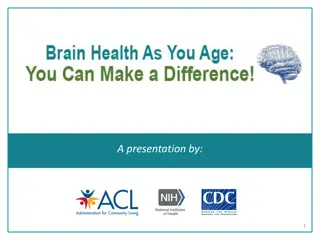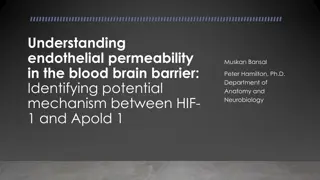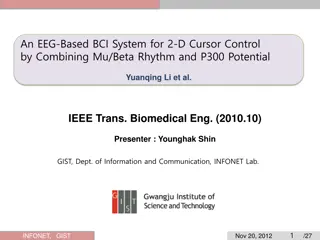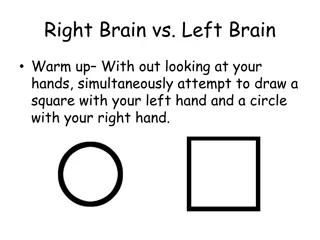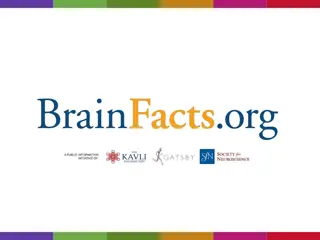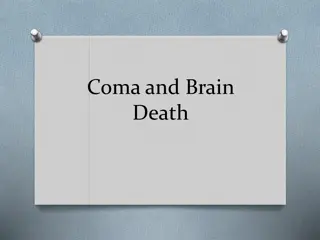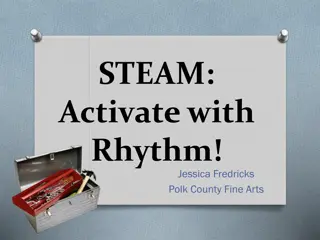Understanding How Your Brain Influences You: Strategies for Control
Delve into the intricate workings of the brain with Kim Long, exploring stress, resilience, and practical strategies to regain control. Learn to differentiate between everyday blues and clinical conditions like SAD, anxiety, and depression. Discover the impact of stress on mental and physical well-being and gain insights on living a purpose-driven life.
Download Presentation

Please find below an Image/Link to download the presentation.
The content on the website is provided AS IS for your information and personal use only. It may not be sold, licensed, or shared on other websites without obtaining consent from the author. Download presentation by click this link. If you encounter any issues during the download, it is possible that the publisher has removed the file from their server.
E N D
Presentation Transcript
How Your Brain Is Taking You Hostage (and what you can do about it)! Kim Long, MC, CCC, R. Psych (Alberta) Director, Dochas Psychological Services, Inc. Spruce Grove, Alberta
Agenda Disclaimer Goals Science stuff Research stress, resilience, how our brains work Strategies Lists of Practice: Calm Place/Grounding Wrap up
Disclaimer Video recording Implied consent No affiliation with Young Living/No profit from sales of their product Participation: Your choice Triggers
Disclaimer Continued YOU are the expert of YOU Advice = grain of salt These are my opinions based in: Research Experiences 2013 Masters of Counselling; 2015 R. Psych Teacher 10 years Elementary and Junior High levels Base Brat (aka military kid) Confidentiality focus will be on my experiences No identifying information given
What About You? Take a moment to think about who YOU are. How do you want to live your life s purpose? Are the choices you make on a daily basis serving that life s purpose? Airplane analogy: Who do you put the oxygen mask on first and why? Are you doing that?
Goals: Education about: The brain and how it works (or doesn t work) Wellness from a mental health perspective Science research Experience Tools that can be used immediately
How to Tell if I Need Therapy Oil change (my bias) Winter blues (Kwong, 2015) 35% of Canadians 10-15% seasonal depression 2-5% SAD How do you tell the difference between blues , nerves , and something clinical, like Seasonal Affective Disorder (SAD), Anxiety, or Depression? Interferes with daily life function (work, relationships, self- care) Others notice Genetic predisposition?
Stress What is stress? A physical, chemical, or emotional factor that causes bodily or mental tension and may be a factor in disease causation or A state resulting from stress; especially: one of bodily or mental tension resulting from factors that tend to alter an existent equilibrium (Merriam-Webster.com, 2017) Equilibrium/homeostasis Don t like change
Containers Analogy: suitcase, pop bottle, tupperware container, etc. Shove emotions/sensations/thoughts away Think: What is your container? Not really paying attention to how much putting away Splits open/Leaks Worst time Under stress/overwhelmed or trying to relax/sleep Having a great day How to make space? i.e. friend who s father died
Types of Stress Environmental: Light (Lambert, Reid, Kaye, Jennings, & Esler, 2002) Serotonin (n.a. (c), 2017) Edmonton Public Library; BTU 10 000 (Johnson, D., 2014) Pollution (Heeken & Polivka, 2015) i.e. China or even smog warnings in Toronto Overcrowding (Burton, 1990) Increased crime and health issues Financial/Situational (Heeken & Polivka, 2015) Lower SES/change in SES Recession/layoffs
Types of Stress Continued Physical: Illness (n.a., 2013) i.e. Brain tumor Pain (n.a., 2013; Wilcox, Veggeberg, Lemme, Hodkinson, Scrivani, Burstein, Beccerra, & Borsook, 2016) i.e. Migraines Emotional: Family/Relationships (Heeken & Polivka, 2015) Graduating/leaving home Grief and loss Divorce/death/significant changes = loss Chronic Stress (n.a., 2013) Impact? Incl. ineffective coping strategies that used to work After mom s diagnosis = stuffing
Resilience Factors caring, supportive relationships (American Psychological Association (APA), 2017) Family/friends (n.a. (b), 2017) = safe place to come back to after exploring world able to plan and carry out plan (APA, 2017) positive view of self and confidence in strengths and abilities (APA, 2017) Self-efficacy (n.a. (b), 2017) skills in communication and problem solving (APA, 2017) Dual awareness: frontal lobe and emotional center (limbic system) capacity to manage strong feelings and impulses i.e. The Hulk
Science Stuff OR: Why Mind, Body, and Emotion? The Three Brains/Triune Brain https://www.youtube.com/watch?v=f-m2YcdMdFw Three brain model (Siegel, 2017) Wrist = spinal cord Palm = brain stem (Reptilian brain; Fisher, 2016) Thumb = limbic system/emotional center (Mammalian brain; Fisher, 2016) 5 senses Palm and thumb = regulate arousal, emotions, and 3 Fs Sensory cortices = store info specific to emotional meaning of senses (Rettner, 2010)
The Brain Fingers = Frontal lobe/cortex Perceive outside world, think, and reason Behind eyes = Prefrontal cortex Regulates subcortical regions (limbic system/brain stem) Limbic system tries to react to perceived threat; prefrontal cortex tries to shut the reaction off
Flipping Your Lid Prefrontal cortex and Cortex offline https://www.youtube.com/watch?v=G0T_2NNoC68 Flipping Your Lid Thumb and palm triggered again and again Like static electricity i.e. Sister and truck drive home - staring Amygdala Hijack (Ahuja, Myat, Cervantes, & Zahn, n.d.) Straw that broke the camel s back i.e. Vacuum and furnace
Memories Hippocampus, prefrontal and frontal cortices, and amygdala Directly linked in memory formation and retrieval (Jin & Maren, 2015; n.a. (a), 2017) Offline = major problem in forming clear memories Triggers are reactions to current events Trigger our body/emotional memories of something not so great Can t id triggers or don t know why we re reacting the way we are no language/story for trigger, just sensation No explanation to label it/reduce charge
Window of Tolerance Steffensen, T., 2010)
Window of Tolerance Stress (esp. chronic) + coping mechanisms that no longer work = vice on either end i.e. Master s degree and laundry Relief the trigger Chronic stress without proper care after = Continuum of illness and symptoms (Arber, 2014) Fatigue/illness Pain Hypervigilance (looking over shoulder, waiting for shoe to drop) Rumination (stewing about events/trying to predict future) Harder to deal with uncertainty Hopelessness Poor memory formation and recall Note: symptoms of anxiety, depression, and PTSD
What Are Strategies You Used To Use That Aren t Working So Great Now? Distraction/Numbness Addictions Stuffing/Ignoring Body issues = IBS Outbursts and Deal with Fallout Relationship casualty Staying Silent/Retreating/Hiding Lack of connection to others/self Note what s missing here Body and emotion strategies, yet effects on body and emotion.
So What? Think about the information in the realms of: Decision making Conversations and relationships Living a full life? Managing stress? What do you think?
Discussion Time 5 minutes
Discussion Time 4 minutes
Discussion Time 3 minutes
Discussion Time 2 minutes
Discussion Time 1 minute
So What? What do you think? If you can stay in all three brains, you will have the ability to fully process trauma/stress; integrate the events Western culture usually only neck up Cortex doesn t function well when triggered Roller coaster of 3 F s and sometimes feeling ok Increased anxiety/tension from being overwhelmed Increased numbness from checking out Technology anyone?
To Consider: Key points: Not about making it go away No Mud, No Lotus Thich Nhat Hanh; Inside Out movie (Chamary, 2015). Harmony Practice when calm easier to access when activated Practice every day reflexive Your choice
Mind: Distraction Mindful change of pattern (reframe): Joe DiSpenza https://www.youtube.com/watch?v=8l2nvTv9_Xw&t=8s Grass path: gives hope Pay attention to body instead and notice moment by moment changes Hexaflexercise activity (ACT; Harris, 2017) Misophonia: know reaction doesn t make sense = NCs Hexaflex helps empower and refocus attention Do something you haven t done in a while to use a different part of the brain: Phone a friend, sudoku, crosswords etc. (i.e. Virtual Hopebox application) PTSD, anxiety, depression
Body: Breath: Usually first resource (intake for client and self) 4 count breath Sighing breath Left/Right breath Light Stream Imagination and visualization Specific body location i.e. ball in throat 4 Elements activity General chronic discomfort Specific trauma protocol but can use parts of it (or all) once used to it Progressive Muscle Relaxation (PMR/Jacobsonian Relaxation) Beware injury! Yoga Note: You cannot maintain a trauma response in a relaxed muscle body! (Gentry & Rhoton, 2017)
Emotion: Use the 5 senses: Hearing Music especially with teens Rain, Rain app Touch i.e. Garnet/Max Smell It reminds me of Memories, strong reactions What emotion goes with that memory? What happens in your body when you smell the scent? Note: Scents can help us feel something different i.e. lilacs = happy childhood More pure the better (Rago, 2017) Taste Why do you think there s such a thing as a food addiction? Because it accesses emotions. Sight Colors (i.e. Dawn/Aspire and grey) Familiar settings (i.e. driving to Cold Lake) Calm Place activity
To Ponder Notice overlap Explore what works best for you Pick and choose what suits situation Body reaction = body strategy Emotion reaction = 5 senses Mind reaction = distraction/use mind in a completely different way
In Practice: Scents Whatever tool depending on client needs NOTE: I have no training in aromatherapy, choices come from client feedback and my own reactions Self-regulation with clients (emotion strategy, Sacred Mountain, Lemon, etc.) Grounding, Calm Place, Muscle tightness YES! reaction Self-regulation for me (Bergamot, Release, etc.) Space feels off (i.e. Jack s and Wilhauk s ) My own mood/body sensations Samples + Chalkboard (Thanks, Yvonne!)
Activities: Calm Place and Grounding Take a moment to notice where you are on a scale from 0-10 0 = meh (no activation) 10 = pulling out your hair, rocking and sobbing in a corner AND body sensations (i.e. where your breath gets stuck) Take a moment after to notice Scale from 0-10 Body sensations A shift of 1 is considered awesome! NOTE: If you are already at a 0-1, think of something that was mildly annoying to you today or yesterday Brings you to a 2-4 on scale Questions?
Calm Place Place in adult life Comfortable, calm, secure Nature, home, or imagination What do you: See Hear Smell Feel (touch) Sense in body?
Calm Place Cont Tap/Butterfly Hug Word/Phrase/Symbol Practice every day when calm Building reflex
Grounding Pick an object Hold in hand Can use scent as well if you prefer! Two adjectives to notice moment by moment experience These can change with each pass Word/phrase Goes to heart/emotional center Breath Usually use sighing, but up to you Use as needed
Whew You Made It! Checklist of goals: Toolbox of strategies you can use Understand to use strategies that fit the symptom Understand brains are amazing, but sometimes they need help too Recognize ways to tell if you or someone you love needs clinical help
Questions? Recordings and presentation available for ONE WEEK at www.dochaspsych.com Contact Info: Kim Long Dochas Psychological Services, Inc. 301, 131 First Avenue, Spruce Grove www.dochaspsych.com klong@dochaspsych.com 780-446-8634 To provide feedback, please go to https://www.surveymonkey.com/r/T87TCN2 (the link is also on my website and Facebook page) or please complete the forms on your tables
References Ahuja, N., Myat, W., Cervantes, A., Zahn, N. (n.d.) Amygdala Hijack. Retrieved from http://neurosciencefundamentals.unsw.wikispaces.net/The+limbic+System American Psychological Association. (2017). The road to resilience. APA Psychology Help Center. Retrieved from http://www.apa.org/helpcenter/road-resilience.aspx Arber, C., (2014). Post-traumatic stress and the brain. Worthit2Be Me. Retrieved from https://worthit2bme.com/post- traumatic-stress-the-brain/ Burton, I. (1990, March). Factors in urban stress. Journal of Sociology & Social Welfare. 17(1), Article 5. Retrieved from http://scholarworks.wmich.edu/cgi/viewcontent.cgi?article=1928&context=jssw Chamary, J.V. (2015, August 30). How inside out explains the science of memory.Retrieved from https://www.forbes.com/sites/jvchamary/2015/08/30/inside-out-science/#4c5123355184 DiSpenza, J. [GlobalSchoolNet]. (2012, August 21). Three brains Thinking to doing to being [Video file]. Retrieved from https://www.youtube.com/watch?v=8l2nvTv9_Xw&t=8s Fisher, J. (2003). Triune Brain [PowerPoiint Slide]. Retrieved from https://i.pinimg.com/736x/5c/4f/f0/5c4ff0143a1340eea15b0d2316b2bcec--ptsd-trauma.jpg Fisher, J. (2016). Working with the neurobiological legacy of trauma [Video recording, course pack]. Jack Hirose and Associates.
References Gentry, E., & Rhoton, R. (2017, May 1). Certified clinical trauma professional (CCTP) intensive training course. PESI.com. Retrieved from https://www.pesi.com/store/onlinecourse. Harris, R. (2017). The Hexaflexercise. [Audio recording] Retrieved from http://thehappinesstrap.com/free-resources/ Heeken, K., & Polivka, L. (2015, November). Environmental and economic factors associated with mental illness. Retrieved from: http://coss.fsu.edu/subdomains/claudepeppercenter.fsu.edu_wp/wp- content/uploads/2016/02/Environmental-and-Economic-Factors-Associated-with- Mental-Illness-Manuscript.pdf Jin, J., Maren, S. (2015). Prefrontal-hippocampal interactions in memory and emotion. Frontiers in Systems Neuroscience, 9(170). Retrieved from https://www.ncbi.nlm.nih.gov/pmc/articles/PMC4678200/ Johnson, D. (2014, February 2). Edmonton public library s Stanley A. Milner branch now sports three mood lights to combat Seasonal Affective Disorder. EdmontonExaminer.com. Retrieved from http://www.edmontonexaminer.com/2014/01/29/edmonton-public-librarys-stanley- a-milner-branch-now-sports-three-mood-lights-to-combat-seasonal-affective- disorder
References Kwong, M. 2015, March 5. Why winter brings us down but won t for long. Canadian Broadcasting Corporation. Retrieved from http:// www.cbc.ca/news/health/sad- science-why-winter-brings-us-down-but-won-t-for-long-1.2981920 Lambert, GW., Reid, C. Kaye, GM., Jennings, GL, & Esler, MD. (2002). Effect of sunlight and season on serotonin turnover in the brain. The Lancet. Retrieved from: http://www.thelancet.com/journals/lancet/article/PIIS0140-6736(02)11737-5/fulltext n.a. (2013). Stress. University of Maryland Medical Center. Retrieved from http://www.umm.edu/health/medical/reports/articles/stress n.a.(a). (2017). Emotions and memory. Psychologists World. Retrieved from https://www.psychologistworld.com/emotion/emotion-memory- psychology#references n.a. (b) (2017). Resilience. Center on the Developing Child: Harvard University. Retrieved from https://developingchild.harvard.edu/science/key-concepts/resilience/ n.a. (c) (2017). Serotonin: What you need to know. Healthline. Retrieved from https://www.healthline.com/health/mental-health/serotonin#overview1
References Rago, R. (2017, December 7). Emotion on the brain [Web log post]. Tufts University. Retrieved from http://sites.tufts.edu/emotiononthebrain/author/rrago01/ Rettner, R. (2010, August 5). Brain s link between sounds, smells, and memory revealed. Live Science Retrieved from https://www.livescience.com/8426-brain-link-sounds- smells-memory-revealed.html Siegel, D. [Dr. Dan Siegel] (2017, August 9). Dr. Dan Siegel s hand model of the brain [Video File]. Retrieved from https://www.youtube.com/watch?v=f-m2YcdMdFw Steffensen, T., (2010, September 30-October 3). Trauma and the challenge of sexual addiction. PowerPoint presentation at Society for the Advancement of Sexual Health, Boston, MA. Stress. (2017). In Merriam-Webster s online dictionary (11th ed.). Retrieved from https://www.merriam-webster.com/dictionary/stress. Nhat Hanh Thich. (2014). No mud, no lotus: The art of transforming suffering. Berkeley, California: Parallax Pr. Wilcox, S. L., Veggeberg, R., Lemme, J., Hodkinson, D. J., Scrivani, S., Brustein, R., Becerra, L., & Borsook, D. (2016, July 26). Increased functional activation of limbic brain regions during negative emotional processing in migraine. Frontiers in Human Neuroscience. doi: https://doilorg/10.3389/fnhum.2016.00366
